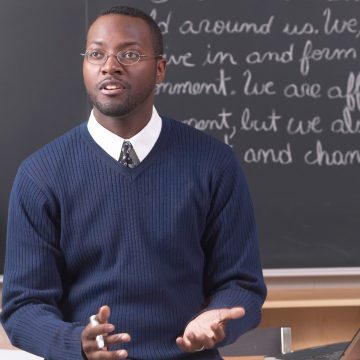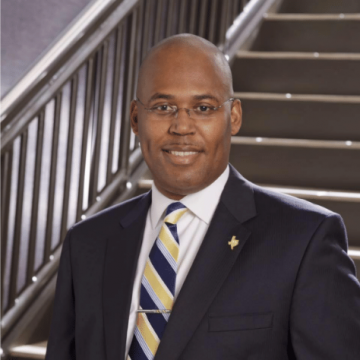The Implications of Teacher Surveys
Martin Haberman
Distinguished Professor
School of Education
University of Wisconsin Milwaukee
What Makes A Job of Work A Profession?
The criteria for deciding whether a job of work is a profession are not all met by every profession, however, most of them must be operative before the term “profession” can be applied to a particular job. Following are the critical criteria, which determine whether a job is a profession.
- The practitioners know and can do things the public in general cannot do. They have a specialized body of knowledge.
- The specialized body of knowledge practitioners have takes an extended period of time to learn.
- The educators who prepare the practitioners are experts who agree upon the specialized body of knowledge practitioners must have.
- Admission to a professional training program is highly selective. It is typical that many more will apply than will be admitted. Being admitted “on probation” to a dental, law, medical, veterinary or architecture college is unheard of.
- Once the practitioners enter practice their behavior reflects the agreed upon body of knowledge and behavior taught to them by the experts.
- Only members of the profession set the standards for licensure and certification.
- The primary responsibility and loyalty of a professional is to serve the client and not simply the institution or governmental agency in which the practitioner may be employed.
- Neither the public at large nor an employing institution may control the way in which professionals relate to their clients, or the treatments, methods or procedures they use.
- Neither the public at large nor an employing institution may set the purpose, goals or objectives for the practitioner’s practice with clients.
- The public at large does not decide how to evaluate professionals.
- Only members of the profession can determine malpractice and dismiss or disbar practitioners.
- Professionals determine the cost of their services.
- The administrators of the institutions in which professionals are employed typically earn less than the practitioners.
- Greater respect is extended to practitioners who continue to work directly with clients than to those who perform administrative functions.
- There is not a continuous churn of practitioners entering and leaving a profession. Once admitted, professionals typically remain and practice on an extended period or on a career long basis.
- Neither the public nor an employing institution determines the specific days, weeks or months in which the professional will perform his/her service to clients.
- Neither the public nor an employing institution determines how many clients a professional practitioner must serve in a given day, week, month or year.
- Professionals do not serve more than one client at a time. They do not provide “professional” services to groups because clients have individual needs.
- Professionals are trained to serve clients with problems. By definition “professionals” do not seek to perform services to clients without problems.
- The status and pay of a professional does not increase as s/he moves further away from direct contact with clients. The highest salary and status is not accorded to individuals (e.g. superintendents) who have no contact with clients at all.
- Professionals share a code of ethics to which they commit and adhere. They cannot be directed to perform or not perform services for clients which conflict with their professional code.
The case that teaching does not meet any of these twenty one criteria can be readily made. Teachers are employees of school districts. Unless they function in compliance with the rules and regulations of their employing district they will not be hired or remain employed. Members of the public determine the content and nature of their services. As employees they have no legitimate control over their practices. It is only on an informal level, the fact that 3.1 million teachers cannot have their behaviors continually monitored and controlled, that they have any discretion at all. The advice to “shut your door and do what you want” does not make teaching a profession. Quite the reverse. It testifies to working conditions in which teachers must sneak activities which their employers might not sanction. If teachers can only demonstrate independent decision-making when they hide their behavior from superiors is that a hallmark of a profession? Legally, teachers have zero discretion over the nature of their training, certification, licensure, practice, or evaluation. Teachers are functionaries, frequently employed in dysfunctional bureaucracies. Teachers cannot decide “best practice”. “Best practice” is circumscribed and determined by what the public and the school boards and administrators who represent the public are willing to condone. If teachers don’t like their employers’ rules and regulations their only choice is to transfer to another school or another district where they can “live with” the conditions under which they must work, or they can quit teaching altogether. This is precisely the choice offered jobholders who are office workers, or who work in retail, or in any other job performed in an organized bureaucracy. Any reasonable analysis of what constitutes a job in contrast to what constitutes a profession will lead to the conclusion that teachers are jobholders who function in publicly run school districts.
Because education “experts” will have their own status lowered if they prepare jobholders rather than professionals, they will not recognize the reality of teachers’ employment and constantly bombard us with blather of what might be done to improve the “profession.” There isn’t any profession. It is difficult, perhaps impossible, for many educational “experts” to comprehend the reality that teachers can perform highly sensitive roles vital to the health and well being of individuals and society, and yet not be professionals. In fact, star teachers of children and youth in poverty effectively perform services, which are a matter of life and death and yet do so while serving in the role of bureaucratic functionaries.
The practices of star teachers reflects a set of functions they perform which are derived from a combination of their belief systems and their clinical experiences of what works in particular settings with specific constituencies. Understanding what teachers do in the real world therefore can only be understood if one uses the criteria of what makes a successful craft. And in the case of teaching, a moral craft that makes learners in a democratic society.
Teachers’ and Administrators’ Opinions Regarding Teaching
Many teachers and administrators have a more realistic perception of teaching than the educators who maintain the fiction that teaching is a profession. If the numerous surveys of teachers’ attitudes are regarded through the lens of reality, the surveys take on new meaning. Following are just a few of the findings from recent polls.
- Finding: When asked the drawbacks of teaching as a career 89% of college graduates less than thirty years of age respond, “Teachers have to worry about personal safety.” Public Agenda (2000) This is a very high percentage and reflects many of the difficulties teachers experience in the major urban districts as well as the extensive media coverage of shootings in suburbs and small towns. In which “profession” is being attacked by the clients, their parents or others a concern of 89% of the professionals?
- Finding: When asked the attributes of a good teacher 56% of practicing teachers agree with the statement that a good teacher has “the skills to design learning experiences that inspire/interest children.” What this means is that almost half (46%) of the teachers who responded did not agree that teachers need any skills in designing learning experiences that inspire/interest children. ETS (2002) What are the implications of having almost half of the teaching force comprised of individuals who believe it is not their function to interest or inspire students?
- Finding: 27% of practicing teachers agreed with the statement “having enthusiasm for the job,” is an attribute of a good teacher. ETS (2002) This means that 73% of the teacher respondents believe that one could be a good teacher without being enthusiastic.
- Finding: 33% of practicing teachers agreed with the statement “having a caring attitude toward students” is an attribute of a good teacher. ETS (2002) This means that 67% of the teacher respondents believe that one could be a good teacher without having a caring attitude toward students.
- Finding: 6% of practicing teachers agreed with the statement “having a lot of involvement with parents” is an attribute of a good teacher. ETS (2002) This means that 94% of teachers do not see involvement with parents as an attribute of good teaching.
- Finding: 3% of practicing teachers agreed with the statement “having an advanced degree from a good school” is an attribute of good teachers. ETS (2002) This means that 97% of teachers do not regard securing a masters degree from a good school as a contribution to good teaching.
- Finding: When graduates of formal training programs offered by Schools of Education were asked to evaluate their training 43% of them reported that they had been prepared to maintain discipline 33% of the principals and superintendents in the districts that employed them agreed. Public Agenda (2000) This means that 57% of the graduates did not feel prepared to maintain discipline and that that 67% of their employers agreed.
- Finding: When graduates of formal training programs offered by Schools of Education were asked to evaluate their training 37% reported that they were prepared to deal with the stress and pressures of teaching. 25% of the principals and superintendents agreed they were prepared to deal with the pressures and stress of teaching. Public Agenda (2000) This means that 63% of the new teachers and 75% of their administrator’s thought they had not been prepared to deal with the pressure and stress of teaching.
- Finding: When experienced teachers were asked to evaluate new teacher graduates of formal training programs they reported that 30% i.e. “more than a few” and “quite a few” needed more content knowledge, 76% needed more effective ways to manage discipline and 75% needed more effective ways to help struggling students. This means that experienced teachers regarded only 24% of new teachers with formal training as able to manage discipline, only 25% able to help struggling students and 70% with adequate content knowledge. Public Agenda (2003)
- Finding: In a study of the kinds of schools new teachers would like to work in they indicated four conditions which were more important to them than salary: good student behavior (86%); supportive administrators (82%); highly motivated and effective teachers (77%); and a school with a mission and philosophy similar to their own (74%). Public Agenda (2000) What is the likelihood that new teachers will find these four conditions? Are the schools where there are teacher shortages characterized by these conditions?
- Finding: In spite of the general concern with dysfunctional bureaucracies in the large school systems, teachers are still hired centrally. Only 35% of principals report having the final say over who is assigned to teach in their schools. MetLife (2005) How can principals be held accountable for the achievement and learning in their schools if they cannot select the new teachers assigned to their schools?
- Finding: In schools serving low income student new teachers report satisfaction with the children (65%), with the other teachers (52%), with the principal 48%) and with the parents 18%. MetLife (2005) This means that new teachers in low income schools are not satisfied with one third of their students, app. half of the other teachers and principals, and over 80% of the parents. How realistic could their programs of preparation have been to lead to this condition? How likely is it that a new teacher dissatisfied with these constituencies can function effectively?
- Finding: Four in ten teachers expect to leave teaching after five years. NCEI (2005). Discipline is the most common reason offered for leaving (40%). Public Agenda (2004) Does this reflect inadequacies in the teachers, their training, the conditions of work, or all three?
- Finding: Over 60% of the teachers in elementary schools in suburban and rural districts perceive their conditions of work to be satisfactory or better. 41% of urban teachers and 35% of teachers of minority students perceive their working conditions as satisfactory. Public Agenda (2000) The “ideal” working conditions in elementary and rural schools still leave 40% of their teachers unsatisfied with the conditions of work. Urban schools and schools serving minorities have a majority and as many as two thirds of their teachers who believe their conditions of work are unsatisfactory.
- Finding: A majority of teachers in low-income schools perceive their problems to be discipline and communicating with parents. Met Life (2005) Is it possible that teachers are not prepared to work in low-income schools? Can a job of work be a “profession” if its services cannot be performed for low-income individuals?
- Finding: When asked for solutions teachers choose lowering class size while principals most frequently cite more professional development. Adults in the general population give high priority to professional development, assigning mentors to beginners and requiring an entrance exam similar to the bar exam. Adults outside of education seem to have the most comprehensive view of what teachers need. Is that an indicator of a profession?
What Does It All Mean?
The perceptions of new teachers are that discipline, parents and personal safety are the biggest problems they will face. They also believe these are the conditions they feel they have been the least prepared to deal with. The surveys clearly reveal that would-be and new teachers prefer to work in schools where students are ready to learn, not in need of remediation, where there are supportive principals and other teachers, and where safety is not a problem. The reasons for leaving are the opposite in the same order: discipline, parents, principals, and conditions of work.
Teacher responses make it clear that they prefer working with students who do not have problems. They make it clear that they would like to perform “professional” services for students who in effect do not need motivation or remediation. A majority do not see performing these functions nor trying to interest/motivate students as things they would like to be doing. Similarly, they see parents as problems and would prefer not to work with them.
By definition, professionals are people who perform services for clients who have problems. Typically, low-income children and youth will have problems of motivation, learning and discipline. Consequently, communicating with their parents in cooperative ways is essential. The overwhelming number of jobs for new teachers will be in dysfunctional urban bureaucracies. If new teacher attitudes are accurate and representative of the 500,000 students in formal teacher education programs then these are individuals with no interest in performing professional services. If children do not need to be motivated, remediated or disciplined and if their parents and caregivers can be ignored then why would it be necessary to provide teachers with any training? The teacher respondents to these surveys seem to be seeking teaching jobs in the best of all non-existent worlds working with students who don’t need teachers. Can a system that selects and certifies such people then declares itself a profession without meeting any criteria of what constitutes professional service be given any credibility?
References
Cogshall, J.G. (2007). Prospects for the profession: Public opinion research on teachers. Washington, D.C: National Comprehensive Center for Teacher Quality.
Feistritzer, E., & Shankar, R.S. (2005). Profile of teachers in the U.S.2005.
Washington, D.C: National Center for Education Information.
Furkus, S., Johnson, J., & Foleno,T. (2000). A sense of calling: Who teacher and why. New York: Public Agenda.
Furkus, S., Johnson, J., & Duffett, A. (2003) What teachers really think about merit pay, unions and other matters. New York: Public Agenda.
Hart, P.D. & Teeter, R.M. (2002). A national priority: Americans speak on teacher quality. Princeton,NJ: ETS.
Markow, D., & Martin, S. (2005). The MetLife survey of the American teacher, 2004-2005:Transitions and the role of supportive relationships. New York: MetLife.






